手势,肢体语言。优点缺点(英文版)
- 格式:ppt
- 大小:1.57 MB
- 文档页数:14
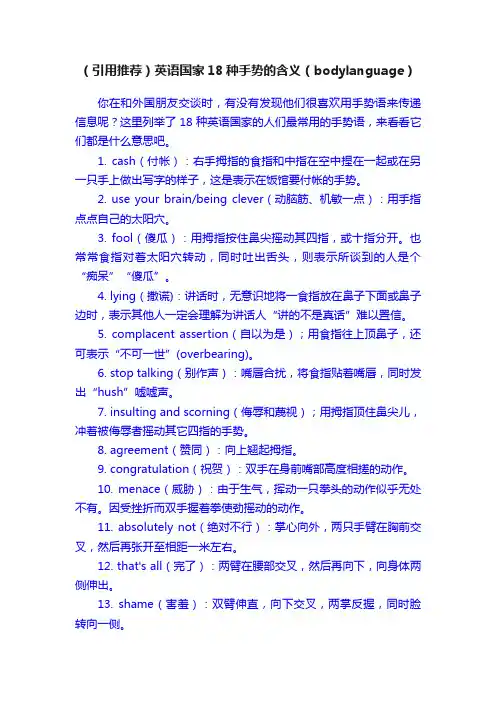
(引用推荐)英语国家18种手势的含义(bodylanguage)你在和外国朋友交谈时,有没有发现他们很喜欢用手势语来传递信息呢?这里列举了18种英语国家的人们最常用的手势语,来看看它们都是什么意思吧。
1. cash(付帐):右手拇指的食指和中指在空中捏在一起或在另一只手上做出写字的样子,这是表示在饭馆要付帐的手势。
2. use your brain/being clever(动脑筋、机敏一点):用手指点点自己的太阳穴。
3. fool(傻瓜):用拇指按住鼻尖摇动其四指,或十指分开。
也常常食指对着太阳穴转动,同时吐出舌头,则表示所谈到的人是个“痴呆”“傻瓜”。
4. lying(撒谎):讲话时,无意识地将一食指放在鼻子下面或鼻子边时,表示其他人一定会理解为讲话人“讲的不是真话”难以置信。
5. complacent assertion(自以为是);用食指往上顶鼻子,还可表示“不可一世”(overbearing)。
6. stop talking(别作声):嘴唇合扰,将食指贴着嘴唇,同时发出“hush”嘘嘘声。
7. insulting and scorning(侮辱和蔑视);用拇指顶住鼻尖儿,冲着被侮辱者摇动其它四指的手势。
8. agreement(赞同):向上翘起拇指。
9. congratulation(祝贺):双手在身前嘴部高度相搓的动作。
10. menace(威胁):由于生气,挥动一只拳头的动作似乎无处不有。
因受挫折而双手握着拳使劲摇动的动作。
11. absolutely not(绝对不行):掌心向外,两只手臂在胸前交叉,然后再张开至相距一米左右。
12. that's all(完了):两臂在腰部交叉,然后再向下,向身体两侧伸出。
13. shame(害羞):双臂伸直,向下交叉,两掌反握,同时脸转向一侧。
14. greeting(打招呼):英语国家的人在路上打招呼,常常要拿帽子表示致意。
现一般已化为抬一下帽子,甚至只是摸一下帽沿。
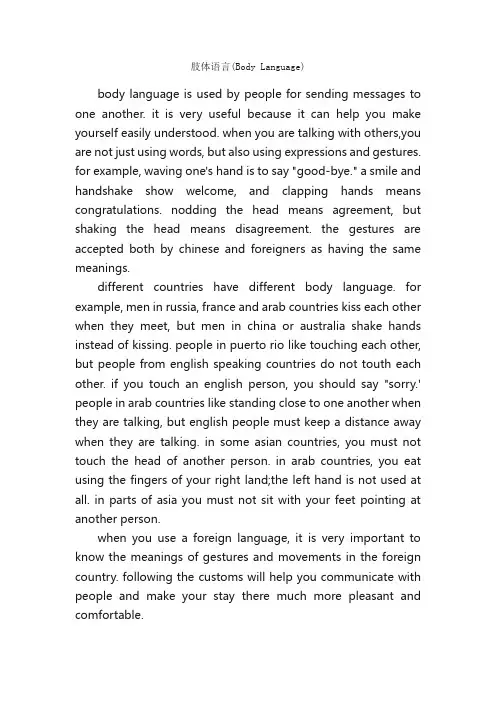
肢体语言(Body Language)body language is used by people for sending messages to one another. it is very useful because it can help you make yourself easily understood. when you are talking with others,you are not just using words, but also using expressions and gestures. for example, waving one's hand is to say "good-bye." a smile and handshake show welcome, and clapping hands means congratulations. nodding the head means agreement, but shaking the head means disagreement. the gestures are accepted both by chinese and foreigners as having the same meanings.different countries have different body language. for example, men in russia, france and arab countries kiss each other when they meet, but men in china or australia shake hands instead of kissing. people in puerto rio like touching each other, but people from english speaking countries do not touth each other. if you touch an english person, you should say "sorry.' people in arab countries like standing close to one another when they are talking, but english people must keep a distance away when they are talking. in some asian countries, you must not touch the head of another person. in arab countries, you eat using the fingers of your right land;the left hand is not used at all. in parts of asia you must not sit with your feet pointing at another person.when you use a foreign language, it is very important to know the meanings of gestures and movements in the foreign country. following the customs will help you communicate with people and make your stay there much more pleasant and comfortable.。
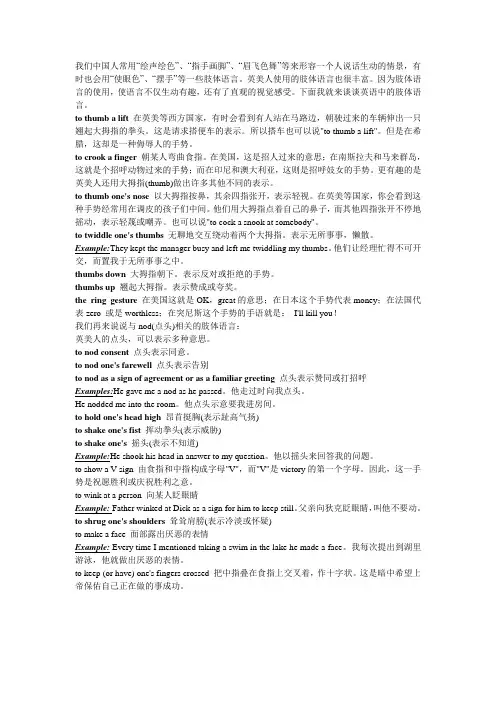
我们中国人常用“绘声绘色”、“指手画脚”、“眉飞色舞”等来形容一个人说话生动的情景,有时也会用“使眼色”、“摆手”等一些肢体语言。
英美人使用的肢体语言也很丰富。
因为肢体语言的使用,使语言不仅生动有趣,还有了直观的视觉感受。
下面我就来谈谈英语中的肢体语言。
to thumb a lift在英美等西方国家,有时会看到有人站在马路边,朝驶过来的车辆伸出一只翘起大拇指的拳头。
这是请求搭便车的表示。
所以搭车也可以说"to thumb a lift"。
但是在希腊,这却是一种侮辱人的手势。
to crook a finger朝某人弯曲食指。
在美国,这是招人过来的意思;在南斯拉夫和马来群岛,这就是个招呼动物过来的手势;而在印尼和澳大利亚,这则是招呼妓女的手势。
更有趣的是英美人还用大拇指(thumb)做出许多其他不同的表示。
to thumb one's nose 以大拇指按鼻,其余四指张开,表示轻视。
在英美等国家,你会看到这种手势经常用在调皮的孩子们中间。
他们用大拇指点着自己的鼻子,而其他四指张开不停地摇动,表示轻蔑或嘲弄。
也可以说"to cock a snook at somebody"。
to twiddle one's thumbs 无聊地交互绕动着两个大拇指。
表示无所事事,懒散。
Example:They kept the manager busy and left me twiddling my thumbs。
他们让经理忙得不可开交,而置我于无所事事之中。
thumbs down大拇指朝下。
表示反对或拒绝的手势。
thumbs up 翘起大拇指。
表示赞成或夸奖。
the ring gesture在美国这就是OK,great的意思;在日本这个手势代表money;在法国代表zero 或是worthless;在突尼斯这个手势的手语就是:I'll kill you!我们再来说说与nod(点头)相关的肢体语言:英美人的点头,可以表示多种意思。
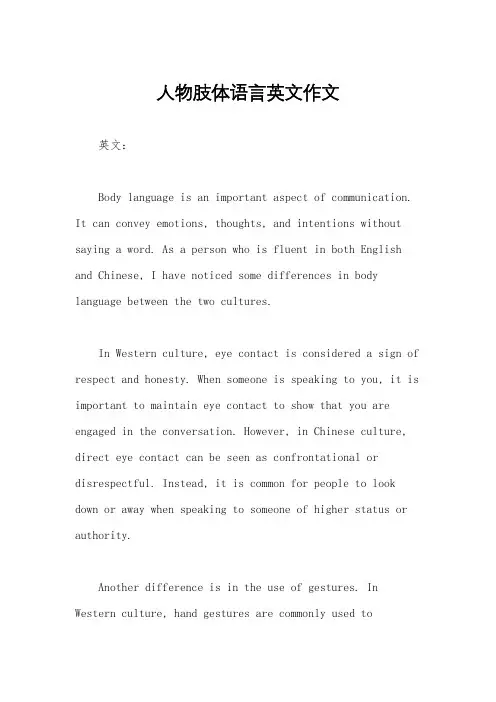
人物肢体语言英文作文英文:Body language is an important aspect of communication. It can convey emotions, thoughts, and intentions without saying a word. As a person who is fluent in both English and Chinese, I have noticed some differences in body language between the two cultures.In Western culture, eye contact is considered a sign of respect and honesty. When someone is speaking to you, it is important to maintain eye contact to show that you are engaged in the conversation. However, in Chinese culture, direct eye contact can be seen as confrontational or disrespectful. Instead, it is common for people to look down or away when speaking to someone of higher status or authority.Another difference is in the use of gestures. In Western culture, hand gestures are commonly used toemphasize a point or express enthusiasm. For example, someone might use a thumbs up to show approval or a shrug to indicate uncertainty. In Chinese culture, gestures are generally more subtle and reserved. It is rare to see someone using large hand movements or exaggerated facial expressions.One common gesture in Chinese culture is the use of the hands to indicate numbers. Instead of using fingers, people will hold up their hands and use different combinations of fingers to represent numbers. This is known as "finger counting" and is a common practice in markets and shops.In both cultures, posture can also convey a lot about a person's emotions and intentions. Slouching or crossing your arms can indicate defensiveness or disinterest, while standing up straight with an open posture can show confidence and engagement.Overall, understanding body language is an important skill in communication. By being aware of cultural differences, we can avoid misunderstandings and connectmore effectively with people from different backgrounds.中文:肢体语言是交流中的重要方面。
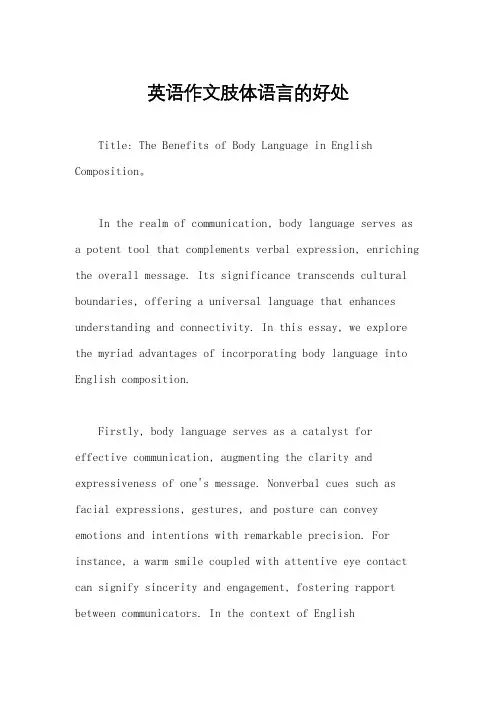
英语作文肢体语言的好处Title: The Benefits of Body Language in English Composition。
In the realm of communication, body language serves as a potent tool that complements verbal expression, enriching the overall message. Its significance transcends cultural boundaries, offering a universal language that enhances understanding and connectivity. In this essay, we explore the myriad advantages of incorporating body language into English composition.Firstly, body language serves as a catalyst for effective communication, augmenting the clarity and expressiveness of one's message. Nonverbal cues such as facial expressions, gestures, and posture can convey emotions and intentions with remarkable precision. For instance, a warm smile coupled with attentive eye contact can signify sincerity and engagement, fostering rapport between communicators. In the context of Englishcomposition, integrating descriptive body language enriches narratives, imbuing characters with depth and authenticity. By vividly portraying their physical mannerisms and facial expressions, writers captivate readers and evoke empathetic responses, thereby elevating the quality of their prose.Moreover, body language enhances the persuasive power of written discourse, influencing readers on a subconscious level. Research indicates that nonverbal cues play a significant role in shaping perceptions and attitudes, often exerting a more profound impact than words alone. When crafting persuasive essays or arguments, writers can leverage body language to underscore key points and evoke empathy in their audience. By incorporating imagery and vivid descriptions of nonverbal behavior, they evoke visceral responses that resonate on an emotional level, compelling readers to empathize with their perspective and consider their arguments more favorably.Furthermore, body language fosters cross-cultural understanding and communication, transcending linguistic barriers and facilitating meaningful connections. Whilespoken language varies across cultures, many nonverbal cues exhibit remarkable consistency across diverse societies. Facial expressions such as smiles, frowns, and nods, along with gestures like handshakes and embraces, convey universal emotions and social signals. In the context of English composition, writers can harness the power of universal body language to bridge cultural divides and engage readers from diverse backgrounds. By infusing their writing with culturally resonant nonverbal cues, they create narratives that resonate with a global audience, fostering empathy and cultural appreciation.Additionally, body language enhances the authenticity and credibility of written communication, fostering trust and resonance with readers. Authenticity is a cornerstone of effective communication, engendering trust andcredibility in the eyes of the audience. By incorporating genuine nonverbal cues into their writing, such as authentic descriptions of characters' body language and emotional responses, writers create narratives that ring true to life, resonating with readers on a deeply human level. Whether crafting fictional stories or persuasiveessays, authenticity imbues writing with sincerity and integrity, compelling readers to invest emotionally in the narrative and consider its message with greater opennessand receptivity.In conclusion, body language serves as a powerful asset in English composition, enriching communication with nuance, expressiveness, and authenticity. By integratingdescriptive nonverbal cues into their writing, authors enhance the clarity, persuasiveness, and cultural resonance of their narratives, fostering deeper connections with readers and amplifying the impact of their message. In an increasingly interconnected world, mastery of body language in written communication is not merely advantageous but essential for effectively engaging and influencing diverse audiences.。
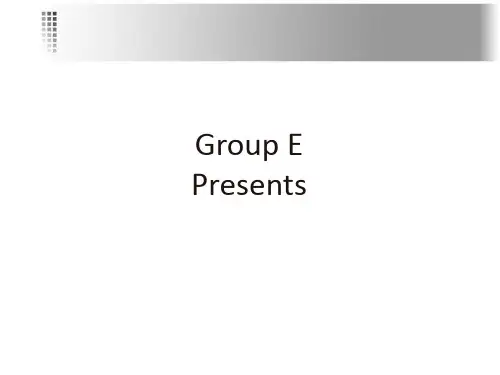

身体语言让你的英语更生动1、付帐(cash):右手拇指、食指和中指在空中捏在一起或在另一只手上作出写字的样子,这是表示在饭馆要付帐的手势。
2、“动脑筋”(use your brains)“机敏一点”(being clever):用手指点点自己的太阳穴。
3、“傻瓜”(fool):用拇指按住鼻尖摇动其四指,或十指分开。
也常常食指对着太阳穴转动,同时吐出舌头,则表示所谈到的人是个“痴呆”“傻瓜”。
4、“讲的不是真话”(lying):讲话时,无意识地将一食指放在鼻子下面或鼻子边时,表示另人一定会理解为讲话人“讲的不是真话”难以置信。
5、自以为是(complacentassertion);用食指往上摁鼻子,还可表示“不可一世” (overbearing)。
6、叫人安静(quietness):闭住嘴,拇指横掠过双唇。
7、“别作声”(stopping-talking):嘴唇合扰,将食指贴着嘴唇,同时发出“hush”嘘嘘声。
8、侮辱和蔑视(insulting and scorning);用拇指顶住鼻尖儿,冲着被侮辱者摇动其它四指的手势。
9、赞同(agreement):向上翘起拇指。
10、祝贺(congratulation):双手在身前嘴部高度相搓的动作。
11、威胁(menace):由于生气,挥动一只拳头的动作似乎无处不有。
也可以是因受挫折而双手握着拳使劲摇动的动作。
12、“绝对不行”(absolutely not):掌心向外,两只手臂在胸前交*,然后再张开至相距一米左右。
13、“完了”(than’s all):两臂在腰部交叉,然后再向下,向身体两侧伸出。
14、“害羞”(shame):双臂伸直,向下交*,两掌反握,同时脸转向一侧。
15、打招呼(greeting):英语国家人在路上打招呼,常常要拿帽子表示致意。
现一般已化为抬一下帽子,甚至只是摸一下帽沿。
16、高兴激动(happiness and excitedness):双手握拳向上举起,前后频频用力摇动。
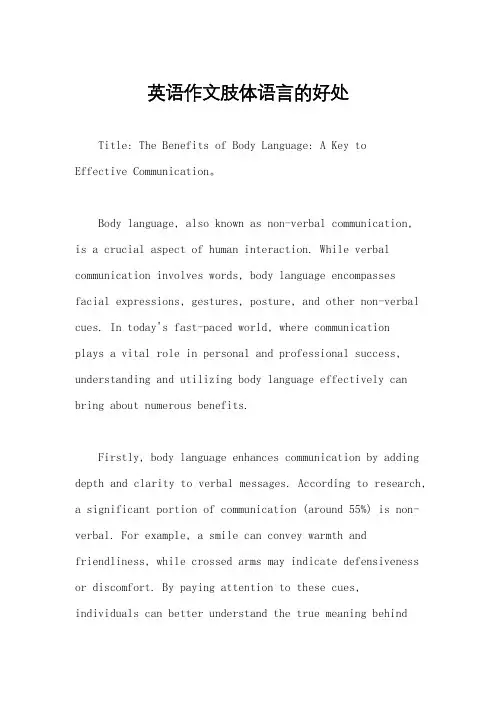
英语作文肢体语言的好处Title: The Benefits of Body Language: A Key toEffective Communication。
Body language, also known as non-verbal communication,is a crucial aspect of human interaction. While verbal communication involves words, body language encompasses facial expressions, gestures, posture, and other non-verbal cues. In today's fast-paced world, where communicationplays a vital role in personal and professional success, understanding and utilizing body language effectively can bring about numerous benefits.Firstly, body language enhances communication by adding depth and clarity to verbal messages. According to research, a significant portion of communication (around 55%) is non-verbal. For example, a smile can convey warmth and friendliness, while crossed arms may indicate defensiveness or discomfort. By paying attention to these cues,individuals can better understand the true meaning behindspoken words, leading to more meaningful and authentic interactions.Moreover, body language can facilitate rapport-building and strengthen relationships. When people mirror eachother's body language, it creates a sense of connection and mutual understanding. This phenomenon, known as mirroring, fosters empathy and rapport between individuals, making them feel more comfortable and at ease in each other's presence. Consequently, effective use of body language can help build trust and strengthen interpersonal bonds, bothin personal and professional settings.In addition to interpersonal communication, body language also plays a crucial role in public speaking and presentations. Research indicates that audiences are more likely to remember and be persuaded by speakers who use confident body language, such as maintaining eye contact, using expressive gestures, and standing tall with open posture. By incorporating these non-verbal elements into their delivery, speakers can captivate their audience, convey confidence and authority, and ultimately, achievetheir communication objectives more effectively.Furthermore, body language can be a powerful tool for conveying emotions and intentions accurately. Unlike words, which can be ambiguous or easily misunderstood, non-verbal cues often provide a more reliable indicator of a person's true feelings. For instance, a clenched jaw or furrowed brow may signal anger or frustration, even if theindividual tries to conceal it verbally. By being attuned to these subtle cues, individuals can better navigatesocial situations, resolve conflicts, and foster positive relationships.Additionally, mastering body language can enhance one's ability to influence and persuade others. Whether in negotiations, sales pitches, or job interviews, the way individuals present themselves non-verbally cansignificantly impact the outcome of the interaction. By exuding confidence, sincerity, and charisma through their body language, individuals can increase their persuasiveness and influence others to agree with their viewpoints or proposals.Moreover, body language can be a valuable tool forself-awareness and self-improvement. By observing their own non-verbal cues, individuals can gain insights into their thoughts, emotions, and behaviors. For example, noticing nervous habits like fidgeting or avoiding eye contact can signal underlying anxiety or insecurity. Armed with this self-awareness, individuals can work on improving their body language to project greater confidence and assertiveness, thus enhancing their overall communication skills and personal effectiveness.In conclusion, body language plays a pivotal role in human communication, offering a myriad of benefits across various aspects of life. From enhancing interpersonal relationships to improving public speaking skills and influencing others, mastering the art of body language can significantly enhance one's communication effectiveness and overall success. Therefore, it is essential for individuals to pay attention to both their verbal and non-verbal cues, striving for congruence and authenticity in their communication efforts. By doing so, they can unlock thefull potential of body language as a powerful tool for connection, persuasion, and personal growth.。
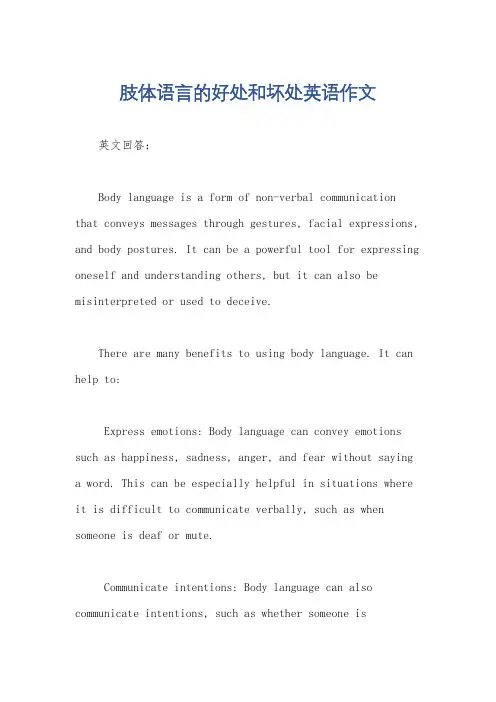
肢体语言的好处和坏处英语作文英文回答:Body language is a form of non-verbal communicationthat conveys messages through gestures, facial expressions, and body postures. It can be a powerful tool for expressing oneself and understanding others, but it can also be misinterpreted or used to deceive.There are many benefits to using body language. It can help to:Express emotions: Body language can convey emotions such as happiness, sadness, anger, and fear without saying a word. This can be especially helpful in situations where it is difficult to communicate verbally, such as when someone is deaf or mute.Communicate intentions: Body language can also communicate intentions, such as whether someone isinterested in talking, wants to be left alone, or is about to attack. This can help to avoid misunderstandings and conflict.Establish rapport: Body language can help to establish rapport and build relationships. When people mirror each other's body language, it creates a sense of connection and trust.Detect deception: Body language can also be used to detect deception. For example, someone who is lying may have difficulty maintaining eye contact, or their body language may be incongruent with their words.However, there are also some potential drawbacks to using body language. These include:Cultural differences: Body language can vary from culture to culture. What is considered to be polite in one culture may be considered to be rude in another. This can lead to misunderstandings and conflict.Misinterpretation: Body language can be misinterpreted, especially if it is out of context. For example, someonewho is crossing their arms may be seen as being defensive, when in fact they are simply cold.Deception: Body language can also be used to deceive. Someone who is trying to hide their true emotions or intentions may use body language to create a false impression.Overall, body language is a powerful tool that can be used to express oneself, understand others, and build relationships. However, it is important to be aware of the potential drawbacks and to use body language in a way thatis appropriate for the situation.中文回答:肢体语言是一种通过手势、面部表情和身体姿势传达信息的非语言交流形式。
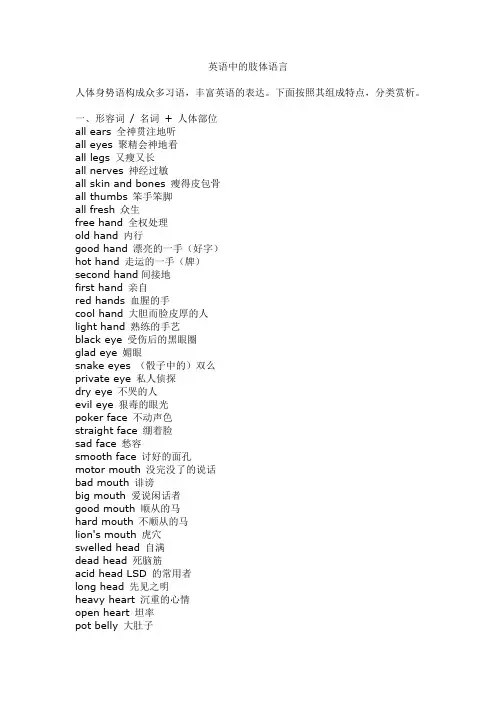
英语中的肢体语言人体身势语构成众多习语,丰富英语的表达。
下面按照其组成特点,分类赏析。
一、形容词/ 名词+ 人体部位all ears 全神贯注地听all eyes 聚精会神地看all legs 又瘦又长all nerves 神经过敏all skin and bones 瘦得皮包骨all thumbs 笨手笨脚all fresh 众生free hand 全权处理old hand 内行good hand 漂亮的一手(好字)hot hand 走运的一手(牌)second hand间接地first hand 亲自red hands 血腥的手cool hand 大胆而脸皮厚的人light hand 熟练的手艺black eye 受伤后的黑眼圈glad eye 媚眼snake eyes (骰子中的)双么private eye 私人侦探dry eye 不哭的人evil eye 狠毒的眼光poker face 不动声色straight face 绷着脸sad face 愁容smooth face 讨好的面孔motor mouth 没完没了的说话bad mouth 诽谤big mouth 爱说闲话者good mouth 顺从的马hard mouth 不顺从的马lion's mouth 虎穴swelled head 自满dead head 死脑筋acid head LSD 的常用者long head 先见之明heavy heart 沉重的心情open heart 坦率pot belly 大肚子stiff neck 顽固之人silver tongue 流利的口才mailed fist 暴力devil's bones 骰子loose lips 说话很随便cold shoulder 冷漠cold feet 胆怯green thumb 在园艺方面有才能的人Achilles heel 弱点busy body 管闲事者sweet tooth 爱吃甜食之人family skeleton 家丑二、人体部位+ 名词brain drain 人才外流brain trust 智囊团brain storm 突有灵感brain child 头脑的产物brain wave 计上心头tongue twister 绕口令face card 带人像的扑克牌face value 票面价值knee slipper 使人笑得拍大腿的笑话eye shot 视野bone shaker 老爷车skin dive 只戴眼罩的潜水skin game 赌博骗钱skull session 坐在一起动脑筋nose dive 一落千丈elbow grease 可施展之地chin music 聊天leg work 跑腿lip praise 表面的称赞lip service 空口的应酬话blood debt 血债belly laugh 捧腹大笑skin flick 色情电影三、动词+ 人体部位keep / save face 保全面子preserve face 保持面子maintain face 维护面子lose face 失去面子make faces 做鬼脸make mouths 对人做嘴脸make eyes 漫送秋波make head 前进count heads 点名knock head 叩头gather head 时机成熟change hands 易手join hands 携手联合kiss hands 吻君王之手hold hands 手搀手change foot 换步set foot 行走play footsie 情侣在桌底下碰脚rub elbow / shoulders 与人交往lose heart 沮丧take heart 鼓起勇气gain flesh 长肉lose flesh 消瘦tell noses 清点人数split hairs 作琐细的分析cut teeth 长牙give lip 讲硬话show leg 逃跑give / throw tongue 猫/狗狂吠shake hands 握手四、人体部位对称或并列face to face 面对面from ear to ear 开心limb to limb 肢解mouth to mouth 嘴对嘴heart to heart 交心shoulder to shoulder 齐头并进eye to eye 赞同eyeball to eyeball 面对面hand to hand 逼近head to head 交头接耳nose to nose 面对面back to back 背靠背hand in hand 手拉手arm in arm 挽臂neck and neck 并驾齐驱leg and leg 平分秋色side by side 肩并肩hand over hand 两手交叉使用from hand to hand 用手传递from mouth to mouth 口口相传from hand to mouth 勉强糊口from head to foot 全身from top to toe 从头到脚hand and foot 手脚一起;尽力heart and soul 全心全意tooth and nail 竭尽全力toe and heel 跳舞flesh and blood 人类head and ears 全身hand to fish 齐心协力hand over fist 多而快地赚钱hand over heels 倒栽葱tooth for tooth 以牙还牙eye for eye 以眼还眼五、人体部位在谚语的运用Two heads are better than one . 三个臭皮匠,胜似一个诸葛亮。

英文中的一些手势我们中国人常用“绘声绘色”、“指手画脚”、“眉飞色舞”等来形容一个人说话生动的情景,有时也会用“使眼色”、“摆手”等一些肢体语言。
英美人使用的肢体语言也很丰富。
因为肢体语言的使用,使语言不仅生动有趣,还有了直观的视觉感受。
下面我就来谈谈英语中的肢体语言。
在英美等西方国家,有时会看到有人站在马路边,朝驶过来的车辆伸出一只翘起大拇指的拳头。
这是请求搭便车的表示。
所以搭车也可以说"to thumb a lift"。
但是在希腊,这却是一种侮辱人的手势。
to crook a finger 朝某人弯曲食指。
在美国,这是招人过来的意思;在南斯拉夫和马来群岛,这就是个招呼动物过来的手势;而在印尼和澳大利亚,这则是招呼妓女的手势。
更有趣的是英美人还用大拇指(thumb)做出许多其他不同的表示。
to thumb one's nose 以大拇指按鼻,其余四指张开,表示轻视。
在英美等国家,你会看到这种手势经常用在调皮的孩子们中间。
他们用大拇指点着自己的鼻子,而其他四指张开不停地摇动,表示轻蔑或嘲弄。
也可以说"to cock a snook at somebody"。
to twiddle one's thumbs 无聊地交互绕动着两个大拇指。
表示无所事事,懒散。
Example:They kept the manager busy and left me twiddling my thumbs.他们让经理忙得不可开交,而置我于无所事事之中。
thumbs down 大拇指朝下。
表示反对或拒绝的手势。
thumbs up 翘起大拇指。
表示赞成或夸奖。
the ring gesture 在美国这就是OK,great的意思;在日本这个手势代表money;在法国代表zero 或是worthless;在突尼斯这个手势的手语就是: I'll kill you!我们再来说说与nod(点头)相关的肢体语言:英美人的点头,可以表示多种意思。
英语交流中应注意的肢体语言作为经常与老外打交道的外贸人士,应该会应付各种场合的情景对话。
当然,很多人会自认为口语好,能应付,但是,一些话语的细节是否使用得周到,就需细细揣摩了。
第一,在与西方人面对面谈话的时候要注意保持一定的距离(keep a certain distance)。
当然,不同社会文化习俗的人保持的距离是不一样的。
对英美人而言,这个距离是3英尺,如果是面对东欧人和南美人,这个距离还可以再近些,但仍要在2英尺以上。
第二,在跟英美人第一次见面相互握手的时候,一定要有点力度,如果握起手来有气无力,或者只伸出手指尖来给人握,就会给对方冷冰冰的感觉,英文中管这种握手叫做wet handshake。
男女之间的握手一般是女方先主动伸出手来,男子不必主动;女方若不伸手,亦可点头致意。
西方人之间(特别是亲属和关系密切的朋友)的见面礼还有拥抱和亲吻,这个我们暂时还用不到。
第三,必须特别指出的一点是eye contact(目光交流),是否有这种目光交流是表明你自信与否的重要手段。
在中国,受几千年传统文化的影响,尤其是在面对长辈的时候,我们会尽可能避开他们的目光,尽量表现得谦虚、恭敬。
但是,在外国人看来,这是一种不诚实的行为,你的话的可信度会大打折扣,甚至他会怀疑你在说谎。
这是我们中国学生在申请奖学金面试和找工作面试的时候最不注意同时也是吃亏最多的地方。
还有一些body language(体态语言)是西方文化里面所特有的,比如:① winking(眨眼睛,使眼色):to convey a message, signal, or suggestion(传达信息、信号或建议)② shrugging(耸肩):to raise the shoulders, especially as a gesture of doubt, disdain, or indifference(抬高肩膀,尤其作为一种表示怀疑、蔑视或漠然的姿式)③ wagging the index finger(摇动食指):disapproval,warning(表示不同意、警告)④ thumbing down(拇指朝下):a “no” sign(表“不赞成、不支持”的符号)⑤ chewing fing ernails(啃手指甲):indicating stress, worry etc.(表示压力、焦虑等)有一些动作是中国文化里所特有的,比如:① covering one’s mouth with one hand while speaking(说话的时候用一只手掩着嘴):saying something secret(说秘密的事情)② staring at strangers(目不转睛地盯着陌生人):showing curiosity(表示好奇)③ pointing to one’s own no se with an index finger(用食指指向自己的鼻子):an “It’s me” gesture (表示“这是我”的手势)④ holding an object with both hands when offering it to sb.(双手捧着某样东西给某人):showing respect(表示尊敬) 以上种种,在和英美人士交流的时候,你得学会灵活运用。
肢体语言的好处和坏处英语作文Benefits and Drawbacks of Body Language.Body language, the nonverbal communication of emotions and thoughts through gestures, facial expressions, and postures, plays a crucial role in interpersonal interactions. Understanding the benefits and drawbacks of body language can enhance communication and foster stronger relationships.Benefits of Body Language.Enhanced Communication: Body language complements verbal communication, providing additional cues thatclarify and reinforce messages. Nonverbal gestures, such as nods or eye contact, indicate engagement and interest, while facial expressions convey emotions that may not be expressed through words.Stronger Emotional Connections: Body languageexpresses emotions in a universal and immediate way. Smiles, frowns, and gestures can bridge cultural and linguistic barriers, creating a shared understanding of feelings and intentions.Improved Self-Awareness: By paying attention to one's own body language, individuals can gain insight into their emotions and motivations. Recognizing the nonverbal cues they send can help them adjust and communicate more effectively.Credibility and Trust: Open and confident body language, such as uncrossed arms and direct eye contact, signals sincerity and reliability. Conversely, closed or nervous body language can raise doubts about the trustworthiness of the speaker.Conflict Resolution: Body language can help identify and diffuse potential conflicts. By observing the nonverbal cues of others, individuals can adjust their own body language to de-escalate situations and promote understanding.Drawbacks of Body Language.Misinterpretation: Body language can be ambiguous and open to interpretation. Gestures and facial expressions can vary across cultures and individuals, leading to misunderstandings or miscommunications.Cultural Differences: Body language norms vary significantly across cultures. What may be consideredpolite in one culture may be offensive in another, making it important to be aware of cultural nuances.False Impressions: Body language can sometimes be deceptive or manipulated to create a desired impression. Individuals may consciously or subconsciously use nonverbal cues to hide their true emotions or deceive others.Limited Expressing Certain Emotions: While body language can convey a range of emotions, it may not be sufficient to express complex or nuanced feelings, such as empathy, regret, or gratitude.Bias and Stereotypes: Body language can be influenced by biases and stereotypes. For example, a person may assume that someone with crossed arms is closed-minded, when in reality they may simply be feeling cold.中文回答:肢体语言的优点和缺点。
肢体语言的益处英语作文Body language, also known as non-verbal communication, plays a crucial role in our daily interactions. It can convey emotions, attitudes, and intentions without the need for words. Here are some of the benefits of body language:1. Building rapport: Body language can help to create a connection with others. For example, maintaining eye contact, smiling, and nodding can show that you are engaged and interested in the conversation.2. Conveying confidence: Confident body language, such as standing tall, making good eye contact, and using open gestures, can help to convey a sense of self-assurance and competence.3. Understanding others: By paying attention to the body language of others, we can gain insights into their emotions and thoughts. For example, crossed arms and a furrowed brow may indicate that someone is feeling defensive or upset.4. Enhancing communication: Body language can complement verbal communication and help to reinforce the messagebeing conveyed. For example, gestures can be used to emphasize key points or to add clarity to a spoken message.5. Building trust: Positive body language, such as afirm handshake and good posture, can help to build trustand credibility with others.6. Resolving conflicts: By being aware of our own body language and that of others, we can better navigatedifficult situations and resolve conflicts more effectively.中文:肢体语言,也被称为非语言交流,在我们日常交往中扮演着至关重要的角色。
恰当使用使用肢体语言的好处英语作文The Power of Body LanguageHave you ever noticed how people move their hands, arms, and body when they talk? That's called body language, and it's a really important way that we communicate without using words. Just like learning to read and write is essential, learning to use good body language is a key skill that can help you in so many ways.What exactly is body language? It refers to the gestures, movements, posture, and facial expressions that people make while communicating. Some examples are things like:Nodding your head to show you understandSmiling when you're happyWaving your hand to say hello or goodbyeMaking eye contact to show you're listeningCrossing your arms when you feel defensivePointing at something to draw attention to itBody language doesn't just happen when we talk though. Even when totally silent, we are constantly sending non-verbalcues and signals through our physicality. The way you hold yourself and move reveals a ton about your thoughts, feelings, and personality.Using good body language is beneficial in so many situations throughout life. First, it makes you a much better communicator. When you match your words with appropriate gestures, expressions, and body movements, it reinforces your message and makes you easier to understand. Good body language also shows self-confidence and helps you command respect from others.In the classroom, having positive body language like sitting up straight, making eye contact, and nodding along attentively can create a great impression with your teacher. They'll see that you are focused, interested, and absorbing the lessons. This can lead to better grades and more opportunities.Body language is also very important when giving speeches or presentations. Using gestures like open palms to emphasize points, adjusting your posture and stance for presence, and making eye contact with the audience makes you look polished and prepared. It shows you are comfortable with public speaking.On the playground and sports fields, body language helps teammates read cues from each other for the next move in the game. Celebrating good plays, congratulating each other, and proper sportsmanship etiquette all come through body language too. Good athletes are masters of intentional body movements.When making new friends, having friendly body language like an open posture, smiling, and making eye contact sets people at ease. It signals that you are warm, approachable, and interested in them. Poor body language like crossing your arms, hunching over, or avoiding eye contact can make you seem rude, nervous, or uninterested which pushes people away.As you get older, understanding body language becomes very valuable for reading people's true thoughts and feelings. Words can be misleading, but physical cues usually don't lie. If someone's body is tense, they are probably feeling stressed even if they say they are "fine." Being able to read these unspoken signals gives you a sixth sense about situations.Body language is also important in the workplace one day. Greeting others with a firm handshake and proper posture creates confidence. Making eye contact in meetings shows you are focused. Adjusting your movements to match the tone of asituation, like being more conservative in formal settings, is professional.Mastering body language can make interacting with others much easier in every area of life. You'll communicate better, create better first impressions, read people's true emotions, look more confident, and show you are focused and interested. Those skills will take you incredibly far!The really great thing about body language is that you can practice it at any time, even by yourself. Watch yourself in a mirror and notice how you hold yourself, how you gesture, and what facial expressions you make. Adjust your physicality to look interested, approachable, and confident. It may feel silly at first, but it builds habits.You can also simply observe others to see what signals they send through body language. Watch characters on TV shows, or people out in public. See if you can read their unspoken cues about thoughts and moods. The more you practice, the better you'll get at recognizing and intentionally using good body language yourself.Like any skill, perfecting body language just takes awareness and practice over time. As you move through school, activities, and life, make it a point to keep tabs on your physicality andmovements. Remember that your body is sharing messages just as much as your voice.With discipline and repetition, you can develop the superpower of controlling your body language. You'll make a much better impression, become a clearer communicator, read people with x-ray vision, and show the world you are confident and capable. Those assets will make you unstoppable at achieving any goal you set!。
肢体语言的益处英语作文80字左右English: Body language plays a crucial role in communication as it helps convey emotions, intentions, and attitudes without the needfor spoken words. It can enhance the message being delivered, provide additional context, and create a stronger connection between individuals. The benefits of using body language include improved understanding between people, increased trust and rapport, and a more effective form of communication in situations where language barriers exist. Additionally, body language can help regulate interactions by signaling attentiveness, interest, or agreement, leading to smoother and more harmonious relationships. Overall, incorporating body language into communication can greatly enhance the effectiveness of interactions and foster better connections between individuals.Translated content: 肢体语言在交流中起着至关重要的作用,因为它可以在不需要言语的情况下传达情绪、意图和态度。
用手势交流的好处英语作文The Benefits of Gesture Communication.Communication is a vital aspect of human interaction, connecting people across languages, cultures, and backgrounds. Within this diverse communication landscape, gestures play a pivotal role, often serving as a universal language that transcends the limitations of spoken words. The benefits of gesture communication are numerous, extending from enhanced understanding and clarity to deeper emotional connections and cultural exchanges.Enhanced Understanding and Clarity.Gestures have the unique ability to amplify and clarify verbal communication. When speaking, people often use hand movements unconsciously to emphasize key points orillustrate abstract concepts. These gestures can greatly assist listeners in comprehending the speaker's message, especially in complex or technical discussions where wordsalone may not suffice. For example, a teacher explaining a scientific concept might wave their hand in a circular motion to demonstrate a cycle, making the concept more tangible and comprehensible for students.Bridging Language Gaps.In cross-cultural or multilingual settings, gesture communication can be a powerful tool for bridging language gaps. When words fail to convey a message due to language barriers, gestures can often serve as a common denominator, facilitating understanding between individuals who may not share a common language. This is particularly evident in international business meetings or tourist interactions, where a simple wave or thumbs-up can convey gratitude, agreement, or understanding without the need for verbal translation.Emotional Connection.Beyond the realm of literal communication, gestures play a crucial role in expressing and receiving emotions.Facial expressions and hand movements can convey a range of emotions from happiness and sadness to anger and surprise. By incorporating gestures into our communication, we can more effectively share our feelings with others, fostering deeper emotional connections and empathy. This emotional exchange is particularly important in interpersonal relationships, where it can foster trust, understanding, and stronger bonds.Cultural Expression.Gestures are often deeply rooted in cultural traditions and practices. Different cultures have their unique sets of gestures that reflect specific values, customs, and social norms. By understanding and incorporating these gestures into our communication, we can gain a deeper understanding of other cultures, appreciate their diversity, and promote cultural exchange. For instance, the handshake is a common gesture of greeting and respect in Western cultures, while the bow is prevalent in East Asian cultures. Understanding these cultural differences can help us navigate social interactions more gracefully and respectfully.Accessibility for the Deaf and Hard of Hearing.For individuals who are deaf or hard of hearing, gesture communication can be a crucial form of expression and understanding. In sign languages like American Sign Language (ASL), gestures and hand movements are used to convey words and phrases, providing a means of communication that is accessible and inclusive. By incorporating gestures into our daily interactions, we can create a more inclusive environment for these individuals, ensuring that they are not excluded from crucial conversations and social exchanges.Conclusion.In summary, gesture communication offers a range of benefits that enhance understanding, bridge language gaps, foster emotional connections, express cultural identity, and promote accessibility. As we continue to evolve and globalize, the importance of gesture communication becomes increasingly apparent. By embracing and incorporatinggestures into our daily interactions, we can create a more connected, understanding, and inclusive world.。